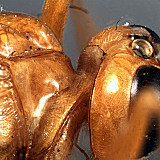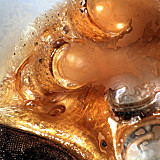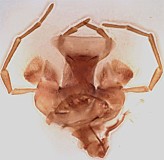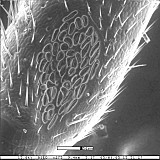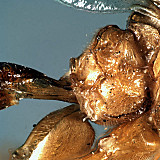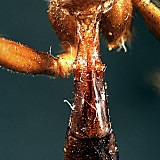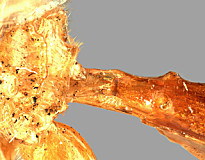Length: body 15-24 mm, fore wing 14-21 mm.
Head: Clypeal margin blunt, very slightly thickened medially, widely truncate. Clypeus 2.3-2.8 times as broad as long, convex in profile, lightly to moderately punctate, without a median transverse sulcus. Anterior tentorial pits elongate and distinctly impressed, epistomal sulcus clearly indicated throughout. Malar space 0.2-0.6 times basal width of mandible. Mandible with ventral tooth slightly longer than dorsal tooth, sides parallel over apical 0.7. Face 1.9-2.1 times as broad as long. Face dorsally with a small median tooth or tubercle, face moderately to densely punctate, slightly rugose medially. Interantennal area with a low (not elevated) median carina that extends posteriorly, often splitting into 2 carinae beyond posterior margin of torulus, though these sometimes less distinct. Frons shallowly concave immediately behind scape; area between antenna and eye very narrow, weakly convex, and sparsely setose. Widest diameter of torulus about equal widest diameter of median ocellus. Ocelli large to very large, distinctly elevated, and very close to one another, distance between eye margin and lateral ocellus 0.3-0.5 times its widest diameter. Frons and vertex polished, faintly and sparsely punctate. Antennae as long as to longer than body, with 39-45 flagellomeres. Length of first flagellomere about 0.8 times widest transverse diameter of eye, second flagellomere about as long as first. Occipital carina complete, joining hypostomal carina distinctly above base of mandible.
Mesosoma: Pronotum dorsally in profile concave, depressed medially, expanded anteriorly, anterior margin truncate, with poorly developed transverse sulcus giving rise to indistinct lateral groove of the pronotum; without epomia or weak transverse ridge. Mesoscutum convex in profile, sometimes lightly punctate; notauli deep, almost reaching posterior margin of mesoscutum. Mesopleuron with broad, fairly sharply defined longitudinal depression for reception of femur. Metapleuron polished, impunctate, carinately rugose, distinctly elevated medially. Propodeum weakly convex, pleural carina complete or nearly so, often interrupted medially, median longitudinal carinae nearly always complete, forming a diamond-shaped areola posteriorly, short anterior transverse carina present medially, posterior transverse carina present laterally, lateral longitudinal carina with at least some remnants present, propodeum otherwise smooth, polished, never rugose nor heavily punctate. Tibia and tarsus slender, longest tibial spur longer than greatest apical width of tibia.
Wings: Fore wing with areolet present, sessile or petiolate; 3rs-m about equal in length to 2rs-m; stalk of areolet, when present, opposite 2m-cu; 1cu-a opposite or distad base of Rs+M by less than 0.5 times its length, almost vertical; marginal cell relatively slender; first subdiscal cell not explanate distally. Hind wing with first abscissa of Cu1 slightly shorter than 1cu-a; distal abscissa of Cu1 tubular and deeply pigmented at least over basal 0.6, more weakly pigmented distally, less distinctly tubular, and sometimes not reaching wing margin.
Metasoma: Glymma deep, wide, the majority of the pit posteriorad dta; T1 narrow anteriorly, widening abruptly just before the middle, with spiracles protruding; S1 reaching 0.8 to 0.9 times distance to spiracle. Dorsal tendon attaches to a platform at the base of a very deep pit; pit excavated in tunnel-like fashion posteriorly.
Color: Orange.

